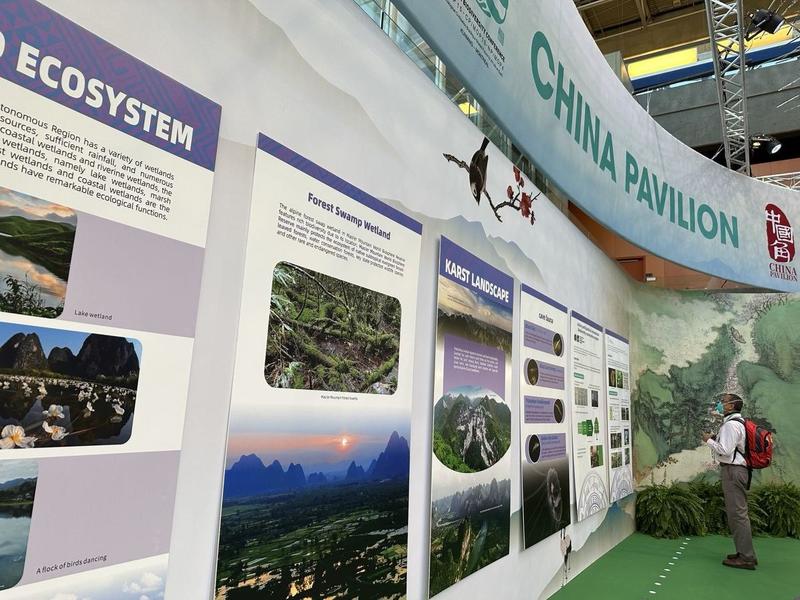Spotlight on nation’s achievements in biodiversity, ecological civilization at UN event in Canada
 An attendee of COP 15 reads the information displayed at the China Pavilion in Montréal, Canada, on Wednesday. (LIU YINMENG / CHINA DAILY)
An attendee of COP 15 reads the information displayed at the China Pavilion in Montréal, Canada, on Wednesday. (LIU YINMENG / CHINA DAILY)
Aglobal dialogue on strengthening the links between nature and cultures to achieve a sustainable and ecological civilization has served to highlight the achievements and actions taken by China.
Officials, experts and nongovernmental organization members gathered at a Nature and Culture summit during COP15, the 15th meeting of the United Nations Conference of the Parties to the Convention on Biological Diversity, on Dec 11 and 12, in support of the implementation of the post-2020 Global Biodiversity Framework.
In his opening remarks at the event in Montreal, Canada, Huang Runqiu, the Chinese minister of ecology and environment and president of COP15, stressed the importance of cultural diversity, especially the experience and knowledge from minority groups.
The relationship between nature and culture is vibrant, said Huang. Culture is deeply intertwined with the natural world. Chinese culture contains a clear concept of harmonious coexistence between humanity and nature, he said.
For example, Yunnan province, where the first phase of the COP15 meeting was held in October last year, is home to 26 traditional ethnic groups and 15 unique minority groups, forming a series of traditional ecological cultures such as the Hani Terrace Culture, the Naxi Dongba Culture, the Dai Long Mountain Culture, and the Tibetan Holy Land Culture.
Their worldviews, cultural values and identities are closely connected to nature, as per the saying, “Humans and nature are half brothers.”
Huang urged nations to protect biodiversity by proposing to “fully respect and protect” the traditional cultures in various places and let the cultural awareness of biodiversity protection be passed on “from generation to generation”.
He also called for strengthening mutual learning and communication between different cultures.
“We need to promote equal exchanges and dialogues between different civilizations and cultures, learn from each other and actively promote the process of global biodiversity governance,” Huang told the Montreal summit.
Pei Shengji, a professor at the Kunming Institute of Botany and Chinese Academy of Sciences, explained how Yunnan is a prime example of the ways that biological and cultural diversity are linked.
The ecosystem of Yunnan, situated in the Eastern Himalayas with an area of 394,000 square kilometers, ranges from low tropical forests to alpine pastures as one of 36 global biodiversity hot spots.
Today, there are 20,000 hectares of traditional tea forest with millions of 100-year-old tea trees maintained by communities. The area’s tea-production value is much higher than that of modern tea gardens, according to Pei.
Xishuangbanna is another tropical lowland area in Yunnan, inhabited by 1.2 million people of different cultural ethnic groups.
“They establish a culture of sacred natural sites, locally known as long forests, where some traditional cultures believe the forest water can rescue the men, leading to the establishment of distinctive cultural landscapes in the area, contributing to the conservation of the tropical rainforest ecosystem,” Pei told the summit via video.
Ma Jun, a founding director of the Beijing-based Institute of Public and Environmental Affairs who has led the development of China’s first environmental public database, discussed action to raise awareness across all sectors on the links between biological and cultural diversity.
Through the launch of the China Pollution Map, as well as the Blue Map, a mobile app that helps the public file “micro reports” against factories violating environmental laws, the NGO’s Green Choice supply chain program and public supervision have motivated more than 20,000 companies to enhance their pollution controls and climate actions.
“During the process, we have witnessed the historic progress made in China’s environmental transparency, the rapid improvement of air and water quality and the restoration of forest grasslands and wetlands. All of these have provided more and better habitats for species,” Ma said.
The summit also featured roundtable discussions focusing on a new joint program of the links between biological and cultural diversity in support of the implementation of the post-2020 GBF.
Priscilla Settee, professor emeritus at Canada’s University of Saskatchewan, noted that there are major battles around intellectual property rights on seed-saving and methods of production and distribution, which cause much human suffering and hunger throughout the world.
“So we need to get our history right. We need to acknowledge the centuries of colonialism … based on global imperialism through land grabs. We need to take a critical look at international free-trade agreements that I call bills of rights for the rich and powerful,” said Settee, whose parents attended a residential school during a dark period in Canada’s history.


